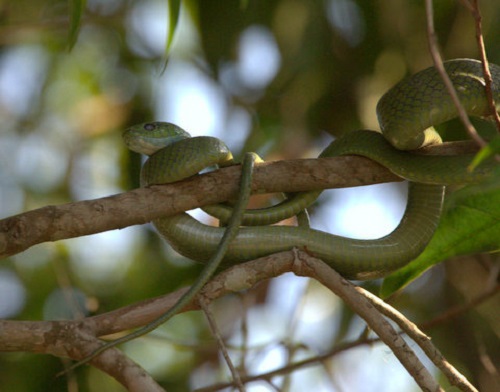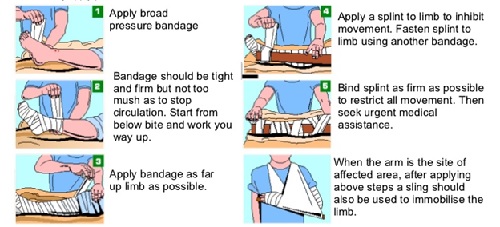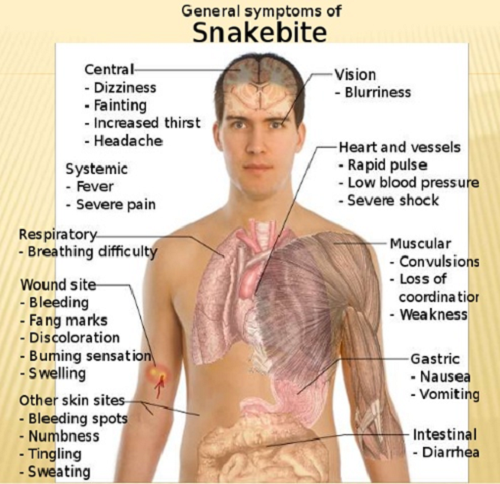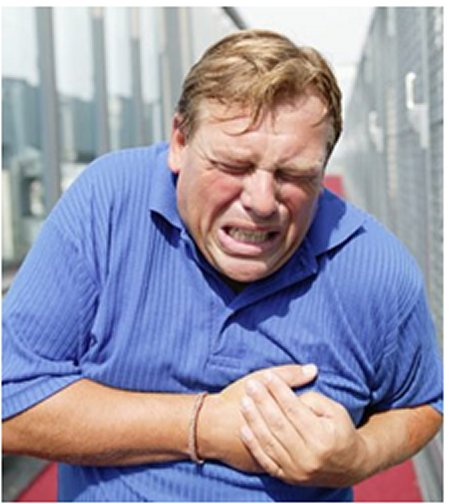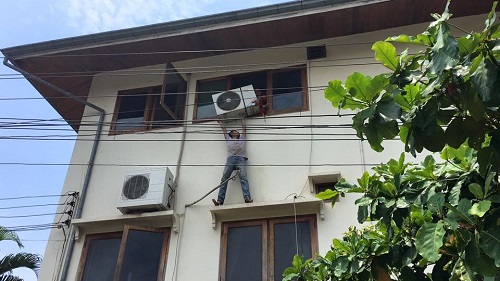Yikes!!! A Snake In My Garden
Snakes are common in Laos and can be found anywhere. Where I come from in Canada we only have one snake and it is non-poisonous. So I find myself nervous when I see a snake in my garden.
Although many people are bitten, less than half are poisoned, even by a poisonous snake, and of these few die.
The danger is that a snake will inject its full dose of poison, in which case the patient has about a 50% chance of death, unless he is treated.
Many snake bites are treated by traditional practitioners in Lao, and of the patients who do arrive in hospital, many arrive late.
There is no anti venom in the villages and very little in the hospitals in Vientiane.
If you are an Expat you can go to the Australian Embassy Clinic. Thailand hospitals also carry anti venom.
Identifying the Snake
Identifying the snake can be important, because it will help Doctors know what antivenin to use, but not being able to identify it should never delay treatment. Doctors can treat based on typical symptoms. Here are some of the typical syndromes.
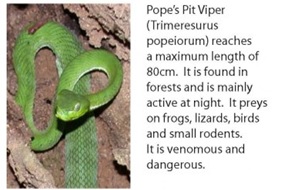 Hemotoxic – Vipers usually cause massive local swelling, abnormal bleeding; and blood which fails to clot; later there is necrosis and gangrene.
Hemotoxic – Vipers usually cause massive local swelling, abnormal bleeding; and blood which fails to clot; later there is necrosis and gangrene.
SHOCK, starting later, is the main cause of death in viper bites. It can be late or early, sometimes within a few minutes of the bite, with abdominal pain, explosive diarrhoea, and collapse.
 Neurotoxic – Cobras, Kraits, and coral snakes. Paralysis varies, and may be extensive and fatal.
Neurotoxic – Cobras, Kraits, and coral snakes. Paralysis varies, and may be extensive and fatal.
Difficulty breathing due to respiratory paralysis, and not able swallow are common. Ptosis (droopy eyes) is the earliest sign (don’t confuse this with sleepiness). 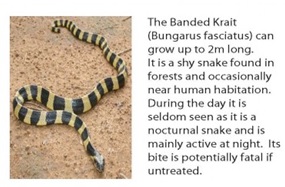 Other effects include: inability to cough, protrude the tongue, smile, or move the lower jaw, and drooling,
Other effects include: inability to cough, protrude the tongue, smile, or move the lower jaw, and drooling,
Snake toxins have a variety of effects, depending on the species.
These include local swelling, capillary oozing, and necrosis; generalized damage to muscles (sea snakes), damage to the heart or kidneys, interference with blood clotting, haemolysis, and various neurotoxic effects.
Snake bite prevention
- Use caution around wood piles, rock crevices etc.
- Watch where you step.
- Do not reach into holes or hidden ledges.
- Do not go into rooms or bathrooms in the dark.
- Use a torch
- Were boots (50% bites on legs) long pants, long sleeves and gloves.
- Don’t sit or step over logs without checking it out first.
- Use a walking stick
- If camping keep tent zipped all the time.
- Stay out of long grass.
- Leave snakes alone
- Hike with a friend
When coming in contact with a snake
- Any unknown snake is potentially dangerous.
- Do not play with snake, avoid any contact with any snake including those of small size, either baby, lethargic, or dead. A dead snake can still bite up to 2 hours after being killed, and a cut off head can keep poisonous activities for several minutes.
- Make yourself familiar with the description of poisonous snakes in the place where you live. Take pictures on your phone to have a record on the snakes in your area. Then if you get bitten you will have a picture to show the hospital.
- Snakes most likely will bite when they feel threatened, are startled, provoked, or have no means of escape when cornered.
- Cobra – lifts vertically the front part of body, opens hood, makes hiss, rushes to the aim.
- Vipers – make a siral from a tail, bend like zigzag front part of the body, and make a strong hiss.
- If you meet a snake, back up slowly, don’t make sudden movements, do not turn your back to the snake, do not run and give the snake possibility to get away.
What to do if someone gets bitten by a snake
- Keep person calm, reassuring them that bites can be effectively treated. Restrict movement and keep the affected area below the heart.
- Remove any rings or constricting items because the affected area may swell. If the area of the bite begins to swell and change color, the snake was probably poisonous.
- Monitor the person’s vital signs — temperature, pulse, rate of breathing, and blood pressure — if possible. If there are signs of shock (such as paleness), lay the person flat, raise the feet about a foot, and cover the person with a blanket.
- If bitten on the body apply direct pressure over the bite site.
- Apply a bandage as follows and if possible carry person to safety.
Note!
- In Lao if you are an expat you can go to the Australian Embassy. They carry anti venom and you can be treated in their clinic. 856 (0) 21 353 840
Remember
- Even if in doubt about whether it is a snakebite or not, do first aid and take the person to the hospital. As a common man, one should know how to administer proper first aid to a snakebite victim, without losing precious time.
- Never try to assess whether it was venomous snakebite or not. As a common man one should treat every snakebite as venomous. Some snake venom (like that of a common Krait) does not show immediate effect even in the case of a serious bite, it is wise to go to a hospital.
- Educate your children that putting ones hand into any holes or playing around wood piles could be dangerous.
 This article has been provided by FAS First Aid Services, known for its experience in first aid and trauma training courses carefully tailored to the needs of each customer in Laos
This article has been provided by FAS First Aid Services, known for its experience in first aid and trauma training courses carefully tailored to the needs of each customer in Laos

